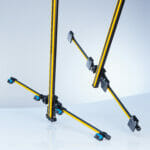~ Why D38999 connectors have been so popular for decades ~
Whether they’re used in a commercial aircraft or onboard a military vehicle, not many electrical components are subjected to extreme conditions in the same way connectors are. Here Emily Rowe, European Product Manager at mission critical electrical connector specialist PEI-Genesis, discusses the benefits of using D38999 connectors in these applications.
Connectors, and more particularly those used in aerospace and military applications, must endure extreme conditions. Often subjected to rapid temperature variations or persistent vibrations, impacts and signal interference, they need to be robust enough to continue operating reliably and safely under these conditions to ensure their users can have 100 per cent trust that the product will get the job done.
Take the industry standard D38999 connector. This is a military-specification electrical connector that was originally designed in the 1970s and is now on its third-generation design. The main reason the D38999 connector soared to popularity is that it offers a much higher density of contacts than its predecessors — 128 contacts compared to only 19 for 5015 connectors.
Like similar connectors, it’s comprised of a few basic components: a hard outer shell, a neoprene rubber insert with holes to house the pins or contacts, and sometimes a backshell on the outer housing that provides additional shielding and durability. Although, one benefit of D38999 connectors is the wide variety of customisation options it can offer such as different shell types, materials, finish and insert arrangements. This makes them appealing to more customers and particularly those in industries that often require a bespoke solution, such as the military and aerospace sectors.
Meeting industry needs
In military applications, we are seeing an increasing need for shielding and durability, with electrical connectors expected to be in service for up to 20 years. This is another area where D38999 connectors shine. With life spans between 500 and 1,500 mating cycles, they can last for up to 30 years depending on the application.
Many customers from the aerospace and military industries require custom components for their applications and D38999 connectors facilitate this since their backshells and contacts are easily customisable. For example, backshells can be supplied in aluminium, stainless steel or composite materials depending on the requirements. Composite options are much newer and are growing in popularity because they are lightweight and offer high performance levels in harsh environments. They are also REACH compliant and QPL qualified for use in military applications.
The customisation options available with D38999 connectors is causing them to grow in popularity in other industries where they were not widely used before, such as the industrial, marine and automotive industries.
For every new application where these connectors are used, there’s something new you can add or change to make it robust and reliable for that industry. All that is left is to choose a reliable connector supplier to meet your demands and, where necessary, provide guidance on the best solution available to you.
PEI-Genesis provides an extensive range of D38999 connectors from Amphenol, ITT Cannon, TE Deutsch, Souriau Eaton and Conesys. Not only that but it also stocks large volumes of component parts and is able to build millions of connector types while offering lead times of 48 hours from the moment you place your order.
Furthermore, it can offer standard solutions or work with customers to create something bespoke for their specific application using its in-house team of design engineers. This is in addition to the fact that it supplies a wide range of accessories for D38999 connectors such as protective caps, backshells, contacts, nut plates for receptacles and tooling.
To learn more about the wide range of D38999 connectors that PEI-Genesis supplies or to discuss a custom D38999 connector solution, visit www.peigenesis.com.







